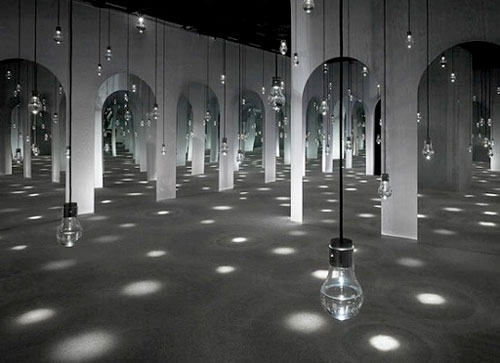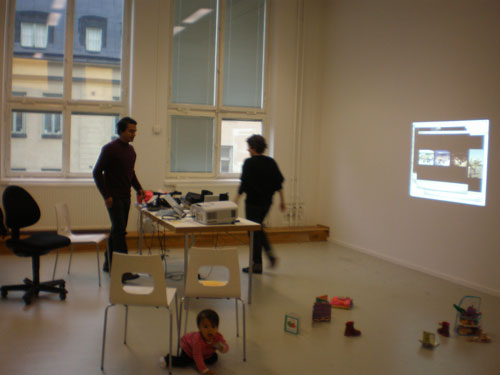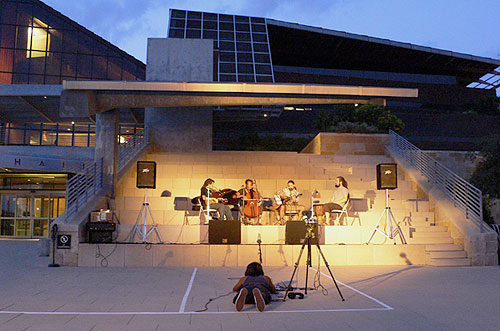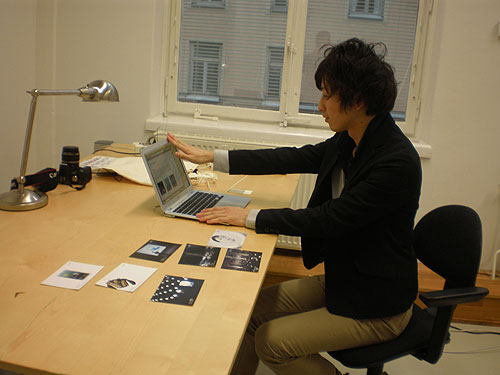A Visit to Iaspis: Notes on Sweden’s Approach to Art and Exhibitions, by Eduardo Navas

Image source: Takram.com
Overture, Installation: Milano Salon, Italy, April 22-27, 2009.
During the early morning of November 5, as Correspondent in Residence for the Swedish Traveling Exhibitions, I visited Iaspis (International Artist Studio Program in Sweden). Unlike my visit to Magasin 3 (which took place the afternoon on the same day), Iaspis was quite close to the hotel where I stayed: a short five minutes walk in the neighborhood of Zinkensdam. I was greeted by Coordinator Suzi Ersahin, who took me around the facilities while explaining Iaspis’s role in Swedish culture.
Iaspis invites international artists for residencies that may range from one to six months, depending on the needs and specific circumstances of each artist. Swedish artists may apply for the residency; Dutch and Nordic artists may also apply through special institutions in their specific regions. Iaspis also supports Swedish artists exhibitions outside the country. Given its spacious facilities, I was surprised to learn that the Residence Program does not organize exhibitions, but does have a periodical open house, in which the residents are able to display their works. Iaspis is also known for its seminars and conferences; and they also publish books on different subjects, ranging from artist monographs to critical reflections on contemporary art issues. Iaspis also offers an archive of its past residents; a resource, which I hope will one day be available online, as I was not able to peruse it as I wished.
During my visit, I met with three artists in residence. The first two, Angel Nevarez and Valerie Tevere are based in New York; their work focuses on the radio as a medium of critical communication. The third, Kotaro Watanabe, is from Japan and functions on the threshold of art and design. In what follows, I share notes about my conversations with the three artists.

Angel Nevarez and Valerie Tevere, and their lovely little one, at work in their studio.
Nevarez and Tevere have developed their practice almost solely (to use their own terms) around transmission, sound production, and mobile broadcast design. They presented to me various projects including one titled “Touching from a Distance.” A two channel video projection which includes people walking while others participate in protests in the plaza de la liberacion, Guadalajara, Jalisco, Mexico. All the while, the Mariachi of Ciudad Guadalajara plays Joy Division’s 1979 song “Transmission.” Even though I did not see the actual video installation, I was able to get an idea of the kind of experience one would get in a proper dimmed room. Further, the cover of “Transmission” may be one of the best I’ve heard to date.

Image source: http://www.nevareztevere.info/
Najeeb Sabour and his band, Austin City Hall Pavilion Stage, August 2008
Nevarez and Tevere’s interest in broadcast communication tends to move around music quite a bit. I noticed this when they showed me another work titled “We Need a Theory To Continue.” They wrote a song based on theoretical texts by Michel Foucault and Katherine Harmon. They gave the lyrics to three bands: The Lovers, Najeeb Sabour, and The Noise Revival Orchestra Experience, who then developed their own arrangements and performed them at Austin City Hall. Nevarez and Tevere recorded each performance with enough pre-and-post-footage so that the three bands could be presented in a three channel installation. The result is a video mashup in which two bands are either setting up or tearing down, while the third performs the song. The lyrics as well as the versions of the songs can be found on the artists’ website.

Kotaro Watanabe recently arrived in his studio at Iaspis.
My meeting with Kotaro Watanabe was quite different. I entered a barren studio space. Watanabe explained that he had just arrived to Stockholm, just a few days before, and that he was settling in; then he said, “I’m a Design Engineer.” And I asked him, “but you make art as well?” Kotaro went on to explain his practice which has a very close relationship with commercial design. One of his pieces titled “Overture” is an installation featuring Toshiba’s lighting technology. The installation consists of a large set of transparent bulb encasings that elegantly hang from the ceiling; they contain water at the bottom, and a light device at the top. The visitors are encouraged to take the bulbs into their hands to discover a heartbeat like vibration. The documentation of this project is quite impressive. Watanabe and his collaborators’ aesthetics is quite consistent as all other projects had a very similar approach.
Watanabe is part of a team of designers and engineers who practice under the name Takram. I am curious to learn what kind of work Watanabe will develop, who explained that he wanted to work with “analog” technology. My meeting with these artists, and my overall sense of Iaspis and its mission leads me to opine that the residency program appears to be open to support artists with diverse interests. More spaces like this one should be created throughout the world.








